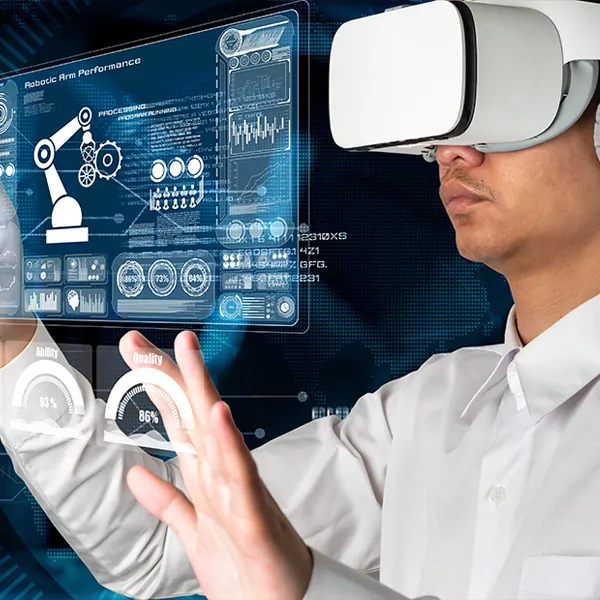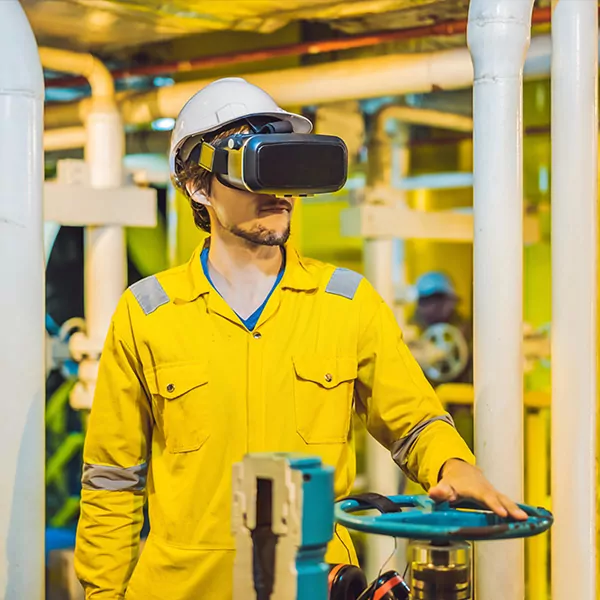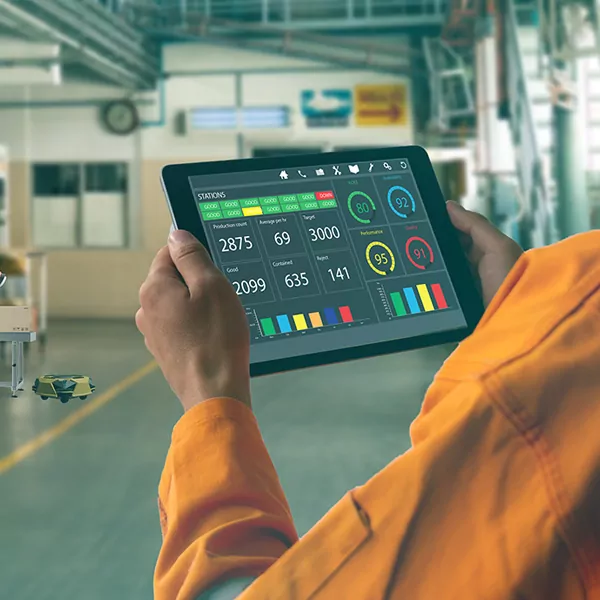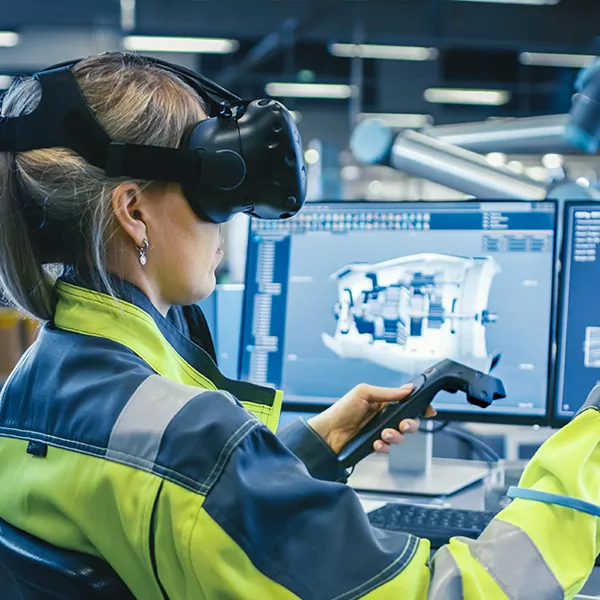Today, manufacturing units employ XR in a range of use cases, such as machine maintenance,
virtual inspections, and training personnel on complex, dangerous machinery. XR improves logistics and
productivity in the manufacturing space, and even helps employees to work more effectively together. XR
is
rapidly gaining traction in the manufacturing sector, where it allows engineers to practice various
“what-if” scenarios in virtual space – ultimately enhancing safety, delivering cost savings, and
improving
speed and accuracy.
Benefits
Enhancing your experience through Extended Reality (XR) technologies
![Drive Efficiency]()
Drive Efficiency
XR offers a lot of potential for operations when it comes to efficiency. Shop floor
operators
can be hands free, and access information that is useable in the moment, right within
their
view. This means shop floor employees do not have to put tools down, pick devices up, or
move to different area to get to a computer.
![Ensure Quality]()
Ensure Quality
XR offers new possibilities for improving quality while lowering costs. Shop floor
workers
can access quality information instantly, rather than stop work to reference a manual.
If
problems happen during production, operators can directly contact a manager to ask
questions
without having to shut the line down.
![Maintain Safety]()
Maintain Safety
Safety is an area where manufacturers can benefit from Extended reality (XR). A
potential
use
case for Extended reality (XR) is to map out the plant layout to determine the best
position
for workstations, tooling, forklifts, machines, and other equipment from a safety and
efficiency standpoint.
![Use Cases]()
Use Cases
We enhance your experience through augmented, virtual, and mixed reality
![Augmented Reality]()
Augmented Reality
Use of AR lets workers easily locate co-workers on the factory floor or know what
machinery
is operating and if it is within normal parameters. Furthermore, it can improve the
production line before components hit the factory floor by streamlining product
development,
making it less time-consuming and more cost-effective.
-
AR reduces the tedious nature of the product development process by
streamlining collaboration between the parties involved. Company directors can see
the
product in development in real-time by using an AR device, letting them offer advice
and
insights without this causing any delays; therefore, boosting productivity and
efficiency.
-
Using AR lets manufacturers streamline predictive maintenance programs.
It
can let workers see the equipment’s potential failure points, letting them quickly
see
if there is a problem and, crucially, identify which parts are at fault. Replacement
parts can then be ordered from a supplier without the need for costly unplanned
downtime.
-
Digital twin technology can be combined with AR in manufacturing
settings
to create virtual clones of a physical asset, providing a dynamic, digital model to
show
technicians how to service and repair machines on the factory floor. This kind of AR
experience lets businesses put in place a more dynamic and cost-effective
maintenance
training program.
![Virtual Reality]()
Virtual Reality
VR has a huge range of benefits to bring to the manufacturing space. With virtual
reality,
employees can get the training they need to work more safely and efficiently in a
manufacturing space. Teams can creatively experiment with new products and designs, and
even
demonstrate the functionality of various items to stakeholders and customers.
-
Building a new product or making changes to an existing design can be a
time-consuming and expensive process. When a product prototype is complete in VR,
there
is no need for stakeholders to travel to see it. VR headsets allow people to view a
design, provide feedback, and make changes much faster – improving time to market.
-
In the manufacturing environment, companies can use VR to build
comprehensive training programs to teach their employees how to use machines
correctly,
as well as how to work in the most efficient way around the plant. This reduces the
risk
to the employees while simultaneously ensuring that work is completed accurately and
quickly.
-
Virtual technologies can simplify and shorten the process of building
factories, as well as making it easier to pinpoint any potential problems with
designs
as quickly as possible. Even things like ergonomics can be refined and tested to
ensure
everything in the plant runs as effectively as possible, boosting worker safety and
improving business output.
![Mixed Reality]()
Mixed Reality
Mixed reality’s interactive and immersive nature allows the user to absorb and retain
more
information and to share their experiences with other people in real-time over long
distances. It simplifies and streamlines complex processes and can help you gain
efficiencies and a competitive advantage by capturing and contextualizing vital data.
-
Many companies have extensive and often outdated manuals that employees
need to check to get an answer to even a simple question. Thanks to mixed reality,
those
same employees can put on a head-mounted display and get the information they need.
This
speeds up the process and reduces the need to check knowledge.
-
The quality assurance process is often very tedious, but it is
essential.
Thanks to MR, information can be laid on top of the real-world object instead of
entered
into a computer, which significantly simplifies the process. QA managers can place
text,
icons, images, and 3D models to real-world objects, allowing the QA process to run
smoother.
-
If your employees are tired of reading printed materials, watching
videos,
or sitting through PowerPoint presentations, then consider replacing such outdated
methods with Mixed reality. All the educational materials can come to life when the
employee puts on a head-mounted display, and they can literally interact with what
they
are learning in real-time.
How it Works
We make it easy to get started and will be there with you every step of the way to ensure a
successful
outcome
01
![Envision Icon]()
Envision
Business Case / Discovery / Brain Storming / Concept Validation
02
![Define Icon]()
Define
Requirements / Prioritize Insights / Define Timelines / Project Costs
03
![Prototype Icon]()
Prototype
Research & Strategy / Conceptual Design / Wireframe / Storyboard High Fidelity Design
04
![Build Icon]()
Build
3D Modeling / Prototyping App Development Integrations / APIs Testing
05
![Test Icon]()
Test
QA Testing / User Testing / Optimization Documentation & Knowledge Transfer
06
![Deploy Icon]()
Deploy
Training / Ready for Launch / Support / Sign-off
Our Blogs
Check out our blogs to learn more about enhancing your experience through Extended Reality (XR)
technologies












